Multi-Scenario Land Use Change Simulation and Spatial Response of Ecosystem Service Value in Black Soil Region of Northeast China
Abstract
1. Introduction
2. Materials and Methods
2.1. Study Area
2.2. Data Source and Technical Route
2.3. ESV Evaluation
2.4. Multi-Scenario Simulation of Land Use Change
2.4.1. PLUS Model and Choice of Driving Factors
2.4.2. Scenario Setting
2.5. Subsection
3. Results
3.1. Analysis of Land Use Change Characteristics from 2000–2020
3.2. Characteristics of ESV Changes from 2000 to 2020
3.3. Simulation of Multi-Scenario Land Use Change in Heilongjiang Province
3.4. ESV Analysis in Different Scenarios in 2035
3.5. Hotspot Analysis
4. Discussion
4.1. Spatial Response of ESV for LUCC
4.2. Development of Future Land Use Policy
4.3. Limitations and Future Work Focus
5. Conclusions
Author Contributions
Funding
Data Availability Statement
Acknowledgments
Conflicts of Interest
References
- Braat, L.C.; de Groot, R. The ecosystem services agenda:bridging the worlds of natural science and economics, conservation and development, and public and private policy. Ecosyst. Serv. 2012, 1, 4–15. [Google Scholar] [CrossRef]
- Lu, Q.; Zhao, C.; Huang, H. Comparative Study on the Temporal and Spatial Evolution of the Ecosystem Service Value of Different Karst Landform Types: A Case Study in Guizhou Province, China. Appl. Sci. 2022, 12, 12801. [Google Scholar] [CrossRef]
- Niu, H.; An, R.; Xiao, D.; Liu, M.; Zhao, X. Estimation of Ecosystem Services Value at a Basin Scale Based on Modified Equivalent Coefficient: A Case Study of the Yellow River Basin (Henan Section), China. Int. J. Environ. Res. Public Health 2022, 19, 16648. [Google Scholar] [CrossRef]
- Ma, Q.; Zhou, M.; Liu, J.; Zhao, J.; Xi, M. Coupling Relationship between Ecosystem Service Value and Socioeconomic Development in the Qinba Mountains, China. Diversity 2022, 14, 1105. [Google Scholar] [CrossRef]
- Cai, G.; Lin, Y.; Zhang, F.; Zhang, S.; Wen, L.; Li, B. Response of Ecosystem Service Value to Landscape Pattern Changes under Low-Carbon Scenario: A Case Study of Fujian Coastal Areas. Land 2022, 11, 2333. [Google Scholar] [CrossRef]
- Fu, B. Promoting Geography for Sustainability. Geogr. Sustain. 2020, 1, 1–7. [Google Scholar] [CrossRef]
- Li, C.; Wu, Y.; Gao, B.; Zheng, K.; Wu, Y.; Li, C. Multi-scenario simulation of ecosystem service value for optimization of land use in the Sichuan-Yunnan ecological barrier, China. Ecol. Indic. 2021, 132, 108328. [Google Scholar] [CrossRef]
- Costanza, R.; de Groot, R.; Braat, L.; Kubiszewski, I.; Fioramonti, L.; Sutton, P.; Farber, S.; Grasso, M. Twenty years of ecosystem services: How far have we come and how far do we still need to go? Ecosyst. Serv. 2017, 28, 1–16. [Google Scholar] [CrossRef]
- Yu, D.; Lu, N.; Fu, B. Establishment of a comprehensive indicator system for the assessment of biodiversity and ecosystem services. Landsc. Ecol. 2017, 32, 1563–1579. [Google Scholar] [CrossRef]
- Zhao, Y.; Han, Z.; Yan, X.; Wang, X. Integrating Spatial Heterogeneity into an Analysis between Ecosystem Service Value and Its Driving Factors: A Case Study of Dalian, China. Int. J. Environ. Res. Public Health 2022, 19, 17055. [Google Scholar] [CrossRef]
- Yang, Y.; Song, G.; Lu, S. Study on the ecological protection redline (EPR) demarcation process and the ecosystem service value (ESV) of the EPR zone: A case study on the city of Qiqihaer in China. Ecol. Indic. 2020, 109, 105754. [Google Scholar] [CrossRef]
- Hong, W.; Jiang, R.; Yang, C.; Zhang, F.; Su, M.; Liao, Q. Establishing an ecological vulnerability assessment indicator system for spatial recognition and management of ecologically vulnerable areas in highly urbanized regions: A case study of Shenzhen, China. Ecol. Indic. 2016, 69, 540–547. [Google Scholar] [CrossRef]
- Stefanidis, S.; Chatzichristaki, C. Response of soil erosion in a mountainous catchment to temperature and precipitation trends. Carpathian J. Earth Environ. Sci. 2017, 12, 35–39. [Google Scholar]
- Zarrineh, N.; Abbaspour, K.C.; Holzkämper, A. Integrated assessment of climate change impacts on multiple ecosystem services in Western Switzerland. Sci. Total Environ. 2020, 708, 135212. [Google Scholar] [CrossRef]
- Ouyang, Z.; Zheng, H.; Xiao, Y.; Polasky, S.; Liu, J.; Xu, W.; Wang, Q.; Zhang, L.; Xiao, Y.; Rao, E.; et al. Improvements in ecosystem services from investments in natural capital. Science 2016, 352, 1455–1459. [Google Scholar] [CrossRef] [PubMed]
- Li, J.; Wang, W.; Hu, G.; Wei, Z. Changes in ecosystem service values in Zoige Plateau, China. Agric. Ecosyst. Environ. 2010, 139, 766–770. [Google Scholar] [CrossRef]
- Obeng, E.A.; Aguilar, F.X. Value orientation and payment for ecosystem services: Perceived detrimental consequences lead to willingness-to-pay for ecosystem services. J. Environ. Manag. 2018, 206, 458–471. [Google Scholar] [CrossRef] [PubMed]
- Egoh, B.; Rouget, M.; Reyers, B.; Knight, A.T.; Cowling, R.M.; van Jaarsveld, A.S.; Welz, A. Integrating ecosystem services into conservation assessments: A review. Ecol. Econ. 2007, 63, 714–721. [Google Scholar] [CrossRef]
- Wainger, L.A.; King, D.M.; Mack, R.N.; Price, E.W.; Maslin, T. Can the concept of ecosystem services be practically applied to improve natural resource management decisions? Ecol. Econ. 2010, 69, 978–987. [Google Scholar] [CrossRef]
- Costanza, R.; d’Arge, R.; de Groot, R.; Farber, S.; Grasso, M.; Hannon, B.; Limburg, K.; Naeem, S.; O’Neill, R.V.; Paruelo, J.; et al. The value of the world’s ecosystem services and natural capital. Nature 1997, 387, 253–260. [Google Scholar] [CrossRef]
- Deng, Y.J.; Hou, M.Y.; Xie, Y.F.; Gao, Q.; Yao, S.B.; Gong, Z.W.; Lu, Y.N.; Jia, L.; Li, Y.Y. Impact of the Grain for Green Project on the temporal and spatial evolution of ecosystem service value in northern Shaanxi. Acta Ecol. Sin. 2020, 40, 6597–6612. [Google Scholar] [CrossRef]
- Fang, L.L.; Xu, D.H.; Wang, L.C.; Niu, Z.G.; Zhang, M. The study of ecosystem services and the comparison of trade-off and synergy in Yangtze River Basin and Yellow River Basin. Geogr. Res. 2021, 40, 821–838. [Google Scholar] [CrossRef]
- Shrestha, B.; Ye, Q.; Khadka, N. Assessment of Ecosystem Services Value Based on Land Use and Land Cover Changes in the Transboundary Karnali River Basin, Central Himalayas. Sustainability 2019, 11, 3183. [Google Scholar] [CrossRef]
- Zhang, B.; Li, L. Evaluation of ecosystem service value and vulnerability analysis of China national nature reserves: A case study of Shennongjia Forest Region. Ecol. Indic. 2023, 149, 110188. [Google Scholar] [CrossRef]
- Friess, D.A.; Yando, E.S.; Wong, L.-W.; Bhatia, N. Indicators of scientific value: An under-recognised ecosystem service of coastal and marine habitats. Ecol. Indic. 2020, 113, 106255. [Google Scholar] [CrossRef]
- Sun, C.; Wang, Y.; Zou, W. The marine ecosystem services values for China based on the emergy analysis method. Ocean Coast. Manag. 2018, 161, 66–73. [Google Scholar] [CrossRef]
- Estoque, R.C.; Myint, S.W.; Wang, C.; Ishtiaque, A.; Aung, T.T.; Emerton, L.; Ooba, M.; Hijioka, Y.; Mon, M.S.; Wang, Z.; et al. Assessing environmental impacts and change in Myanmar’s mangrove ecosystem service value due to deforestation (2000–2014). Glob. Chang. Biol. 2018, 24, 5391–5410. [Google Scholar] [CrossRef]
- Zhang, M.; Dilinuer, A.J. Evaluation of ecosystem service value of constructed wetland on the west bank of the Bosten Lake. Trans. Oceanol. Limnol. 2021, 43, 169–174. [Google Scholar] [CrossRef]
- Guo, H.Y.; Wang, Y.R.; Lu, Q.; Zhou, J.X.; Wei, Q.Z. Assessment on the eco-service value in karst rocky desert: A case study in Jinsha County. Carsologica Sin. 2013, 32, 211–217. [Google Scholar] [CrossRef]
- Zhao, N.; Wang, H.; Zhong, J.; Sun, D. Assessment of Recreational and Cultural Ecosystem Services Value of Islands. Land 2022, 11, 205. [Google Scholar] [CrossRef]
- Petway, J.R.; Lin, Y.-P.; Wunderlich, R.F. A Place-Based Approach to Agricultural Nonmaterial Intangible Cultural Ecosystem Service Values. Sustainability 2020, 12, 699. [Google Scholar] [CrossRef]
- Xie, G.D.; Lu, C.X.; Leng, Y.F.; Zheng, D.U.; Li, S.C. Ecological assets valuation of the Tibetan Plateau. J. Nat. Resour. 2003, 18, 189–196. [Google Scholar] [CrossRef]
- Xie, G.; Zhang, C.; Zhen, L.; Zhang, L. Dynamic changes in the value of China’s ecosystem services. Ecosyst. Serv. 2017, 26, 146–154. [Google Scholar] [CrossRef]
- Zhang, M.; Ao, Y.; Liu, M.; Zhao, Y.; Lin, K.; Cheng, T. Ecological security assessment based on ecosystem service value and ecological footprint in the Pearl River Delta urban agglomeration, China. Ecol. Indic. 2022, 144, 109528. [Google Scholar] [CrossRef]
- Wang, Y.; Pan, J. Building ecological security patterns based on ecosystem services value reconstruction in an arid inland basin: A case study in Ganzhou District, NW China. J. Clean. Prod. 2019, 241, 118337. [Google Scholar] [CrossRef]
- Zhou, X.; Ma, M.; Chen, Q.; Qi, W.; Gao, Y.; Cui, J. Uneven Distribution of Ecosystem Services along the Yarlung Zangbo River Basin in Tibet Reveals the Quest for Multi-Target Policies of Rural Development in Less-Favored Areas. Land 2022, 11, 1961. [Google Scholar] [CrossRef]
- Luo, Q.; Zhou, J.; Li, Z.; Yu, B. Spatial differences of ecosystem services and their driving factors: A comparation analysis among three urban agglomerations in China’s Yangtze River Economic Belt. Sci. Total Environ. 2020, 725, 138452. [Google Scholar] [CrossRef] [PubMed]
- Cai, T.; Luo, X.; Fan, L.; Han, J.; Zhang, X. The Impact of Cropland Use Changes on Terrestrial Ecosystem Services Value in Newly Added Cropland Hotspots in China during 2000–2020. Land 2022, 11, 2294. [Google Scholar] [CrossRef]
- Lin, W.; Sun, Y.; Nijhuis, S.; Wang, Z. Scenario-based flood risk assessment for urbanizing deltas using future land-use simulation (FLUS): Guangzhou Metropolitan Area as a case study. Sci. Total Environ. 2020, 739, 139899. [Google Scholar] [CrossRef] [PubMed]
- Wei, Q.; Abudureheman, M.; Halike, A.; Yao, K.; Yao, L.; Tang, H.; Tuheti, B. Temporal and spatial variation analysis of habitat quality on the PLUS-InVEST model for Ebinur Lake Basin, China. Ecol. Indic. 2022, 145, 109632. [Google Scholar] [CrossRef]
- Shi, Q.; Gu, C.-J.; Xiao, C. Multiple scenarios analysis on land use simulation by coupling socioeconomic and ecological sustainability in Shanghai, China. Sustain. Cities Soc. 2023, 95, 104578. [Google Scholar] [CrossRef]
- Liang, X.; Guan, Q.; Clarke, K.C.; Liu, S.; Wang, B.; Yao, Y. Understanding the drivers of sustainable land expansion using a patch-generating land use simulation (PLUS) model: A case study in Wuhan, China. Comput. Environ. Urban Syst. 2021, 85, 101569. [Google Scholar] [CrossRef]
- Saxena, A.; Jat, M.K. Capturing heterogeneous urban growth using SLEUTH model. Remote Sens. Appl. Soc. Environ. 2019, 13, 426–434. [Google Scholar] [CrossRef]
- Hemati, T.; Pourebrahim, S.; Monavari, M.; Baghvand, A. Species-specific nature conservation prioritization (a combination of MaxEnt, Co$ting Nature and DINAMICA EGO modeling approaches). Ecol. Model. 2020, 429, 109093. [Google Scholar] [CrossRef]
- Liu, X.; Liang, X.; Li, X.; Xu, X.; Ou, J.; Chen, Y.; Li, S.; Wang, S.; Pei, F. A future land use simulation model (FLUS) for simulating multiple land use scenarios by coupling human and natural effects. Landsc. Urban Plan. 2017, 168, 94–116. [Google Scholar] [CrossRef]
- Wang, Y.; Li, X.; Zhang, Q.; Li, J.; Zhou, X. Projections of future land use changes: Multiple scenarios-based impacts analysis on ecosystem services for Wuhan city, China. Ecol. Indic. 2018, 94, 430–445. [Google Scholar] [CrossRef]
- Verburg, P.H.; Overmars, K.P. Combining top-down and bottom-up dynamics in land use modeling: Exploring the future of abandoned farmlands in Europe with the Dyna-CLUE model. Landsc. Ecol. 2009, 24, 1167–1181. [Google Scholar] [CrossRef]
- Verburg, P.H.; Koomen, E.; Hilferink, M.; Pérez-Soba, M.; Lesschen, J.P. An assessment of the impact of climate adaptation measures to reduce flood risk on ecosystem services. Landsc. Ecol. 2012, 27, 473–486. [Google Scholar] [CrossRef]
- Deal, R.L.; Cochran, B.; LaRocco, G. Bundling of ecosystem services to increase forestland value and enhance sustainable forest management. For. Policy Econ. 2012, 17, 69–76. [Google Scholar] [CrossRef]
- Wang, L.-J.; Ma, S.; Zhao, Y.-G.; Zhang, J.-C. Ecological restoration projects did not increase the value of all ecosystem services in Northeast China. For. Ecol. Manag. 2021, 495, 119340. [Google Scholar] [CrossRef]
- Ramankutty, N.; Mehrabi, Z.; Waha, K.; Jarvis, L.; Kremen, C.; Herrero, M.; Rieseberg, L.H. Trends in Global Agricultural Land Use: Implications for Environmental Health and Food Security. Annu. Rev. Plant Biol. 2018, 69, 789–815. [Google Scholar] [CrossRef] [PubMed]
- Laurance, W.F.; Sayer, J.; Cassman, K.G. Agricultural expansion and its impacts on tropical nature. Trends Ecol. Evol. 2014, 29, 107–116. [Google Scholar] [CrossRef] [PubMed]
- Zhang, X.; Ren, W.; Peng, H. Urban land use change simulation and spatial responses of ecosystem service value under multiple scenarios: A case study of Wuhan, China. Ecol. Indic. 2022, 144, 109526. [Google Scholar] [CrossRef]
- Costanza, R.; de Groot, R.; Sutton, P.; van der Ploeg, S.; Anderson, S.J.; Kubiszewski, I.; Farber, S.; Turner, R.K. Changes in the global value of ecosystem services. Glob. Environ. Chang. 2014, 26, 152–158. [Google Scholar] [CrossRef]
- Niu, Y.; Xie, G.; Xiao, Y.; Liu, J.; Wang, Y.; Luo, Q.; Zou, H.; Gan, S.; Qin, K.; Huang, M. Spatiotemporal Patterns and Determinants of Grain Self-Sufficiency in China. Foods 2021, 10, 747. [Google Scholar] [CrossRef] [PubMed]
- Luan, C.; Liu, R. A Comparative Study of Various Land Use and Land Cover Change Models to Predict Ecosystem Service Value. Int. J. Environ. Res. Public Health 2022, 19, 16484. [Google Scholar] [CrossRef]
- Jia, W.; Gu, X.; Mi, X.; Yang, J.; Zang, W.; Liu, P.; Yan, J.; Zhu, H.; Zhang, X.; Zhang, Z. Multi-Scale Spatiotemporal Pattern Analysis and Simulation (MSPAS) Model with Driving Factors for Land Cover Change and Sustainable Development Goals: A Case Study of Nepal. Remote Sens. 2022, 14, 6295. [Google Scholar] [CrossRef]
- Bashir, O.; Bangroo, S.A.; Guo, W.; Meraj, G.; TAyele, G.; Naikoo, N.B.; Shafai, S.; Singh, P.; Muslim, M.; Taddese, H.; et al. Simulating Spatiotemporal Changes in Land Use and Land Cover of the North-Western Himalayan Region Using Markov Chain Analysis. Land 2022, 11, 2276. [Google Scholar] [CrossRef]
- Han, J.; Hu, Z.; Wang, P.; Yan, Z.; Li, G.; Zhang, Y.; Zhou, T. Spatio-temporal evolution and optimization analysis of ecosystem service value—A case study of coal resource-based city group in Shandong, China. J. Clean. Prod. 2022, 363, 132602. [Google Scholar] [CrossRef]
- Long, X.; Lin, H.; An, X.; Chen, S.; Qi, S.; Zhang, M. Evaluation and analysis of ecosystem service value based on land use/cover change in Dongting Lake wetland. Ecol. Indic. 2022, 136, 108619. [Google Scholar] [CrossRef]
- Wang, L.; Chen, C.; Xie, F.; Hu, Z.; Zhang, Z.; Chen, H.; He, X.; Chu, Y. Estimation of the value of regional ecosystem services of an archipelago using satellite remote sensing technology: A case study of Zhoushan Archipelago, China. Int. J. Appl. Earth Obs. Geoinf. 2021, 105, 102616. [Google Scholar] [CrossRef]
- Huang, Y.; Lin, T.; Zhang, G.; Jones, L.; Xue, X.; Ye, H.; Liu, Y. Spatiotemporal patterns and inequity of urban green space accessibility and its relationship with urban spatial expansion in China during rapid urbanization period. Sci. Total Environ. 2022, 809, 151123. [Google Scholar] [CrossRef] [PubMed]
- Grizzetti, B.; Liquete, C.; Pistocchi, A.; Vigiak, O.; Zulian, G.; Bouraoui, F.; De Roo, A.; Cardoso, A.C. Relationship between ecological condition and ecosystem services in European rivers, lakes and coastal waters. Sci. Total Environ. 2019, 671, 452–465. [Google Scholar] [CrossRef] [PubMed]
- Wang, Y.; Zhang, Z.; Chen, X. Spatiotemporal change in ecosystem service value in response to land use change in Guizhou Province, southwest China. Ecol. Indic. 2022, 144, 109514. [Google Scholar] [CrossRef]
- Zheng, D.; Wang, Y.; Hao, S.; Xu, W.; Lv, L.; Yu, S. Spatial-temporal variation and tradeoffs/synergies analysis on multiple ecosystem services: A case study in the Three-River Headwaters region of China. Ecol. Indic. 2020, 116, 106494. [Google Scholar] [CrossRef]
- Small, N.; Munday, M.; Durance, I. The challenge of valuing ecosystem services that have no material benefits. Glob. Environ. Chang. 2017, 44, 57–67. [Google Scholar] [CrossRef]
- Huang, C.; Zhao, D.; Deng, L. Landscape pattern simulation for ecosystem service value regulation of Three Gorges Reservoir Area, China. Environ. Impact Assess. Rev. 2022, 95, 106798. [Google Scholar] [CrossRef]
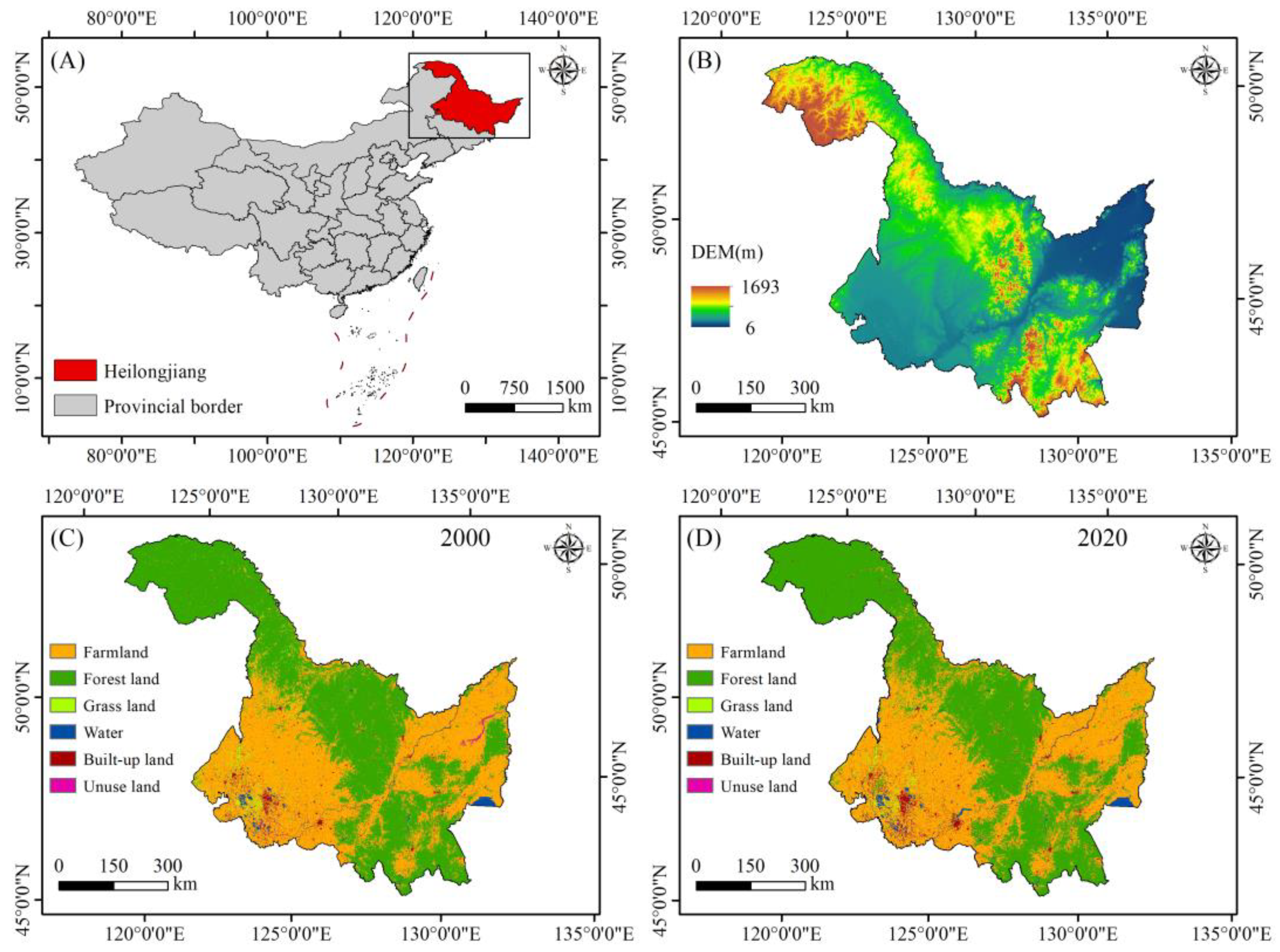
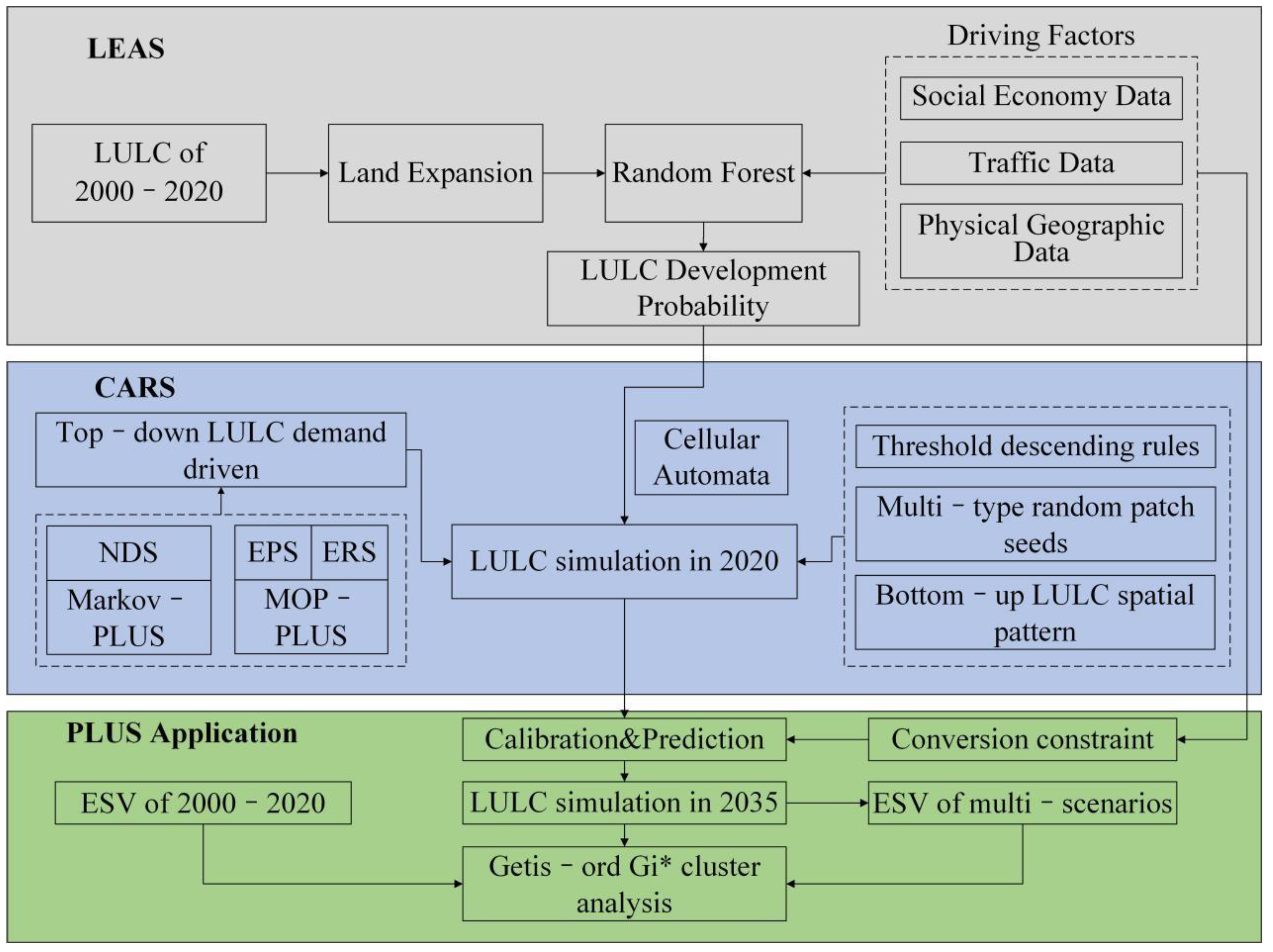
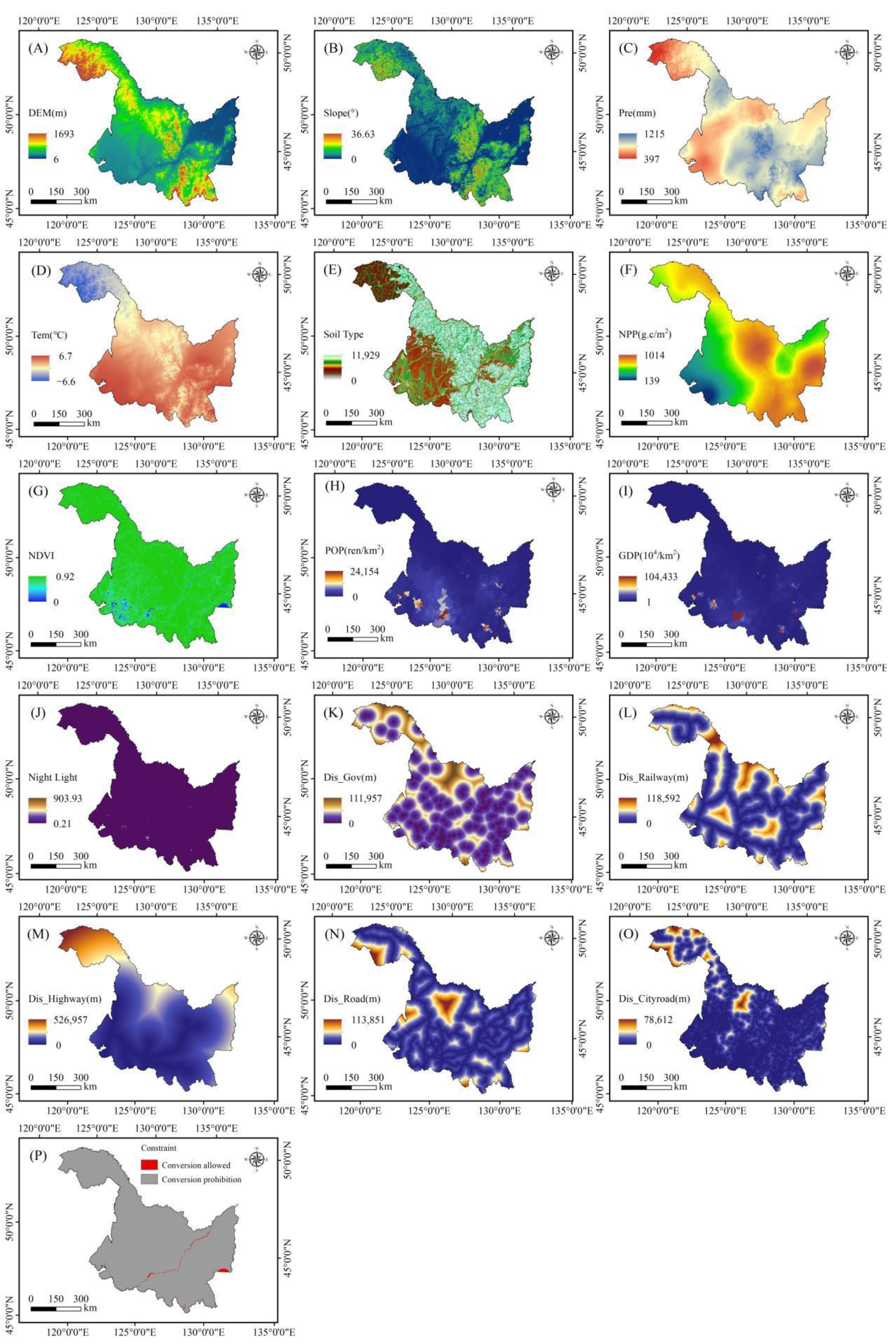



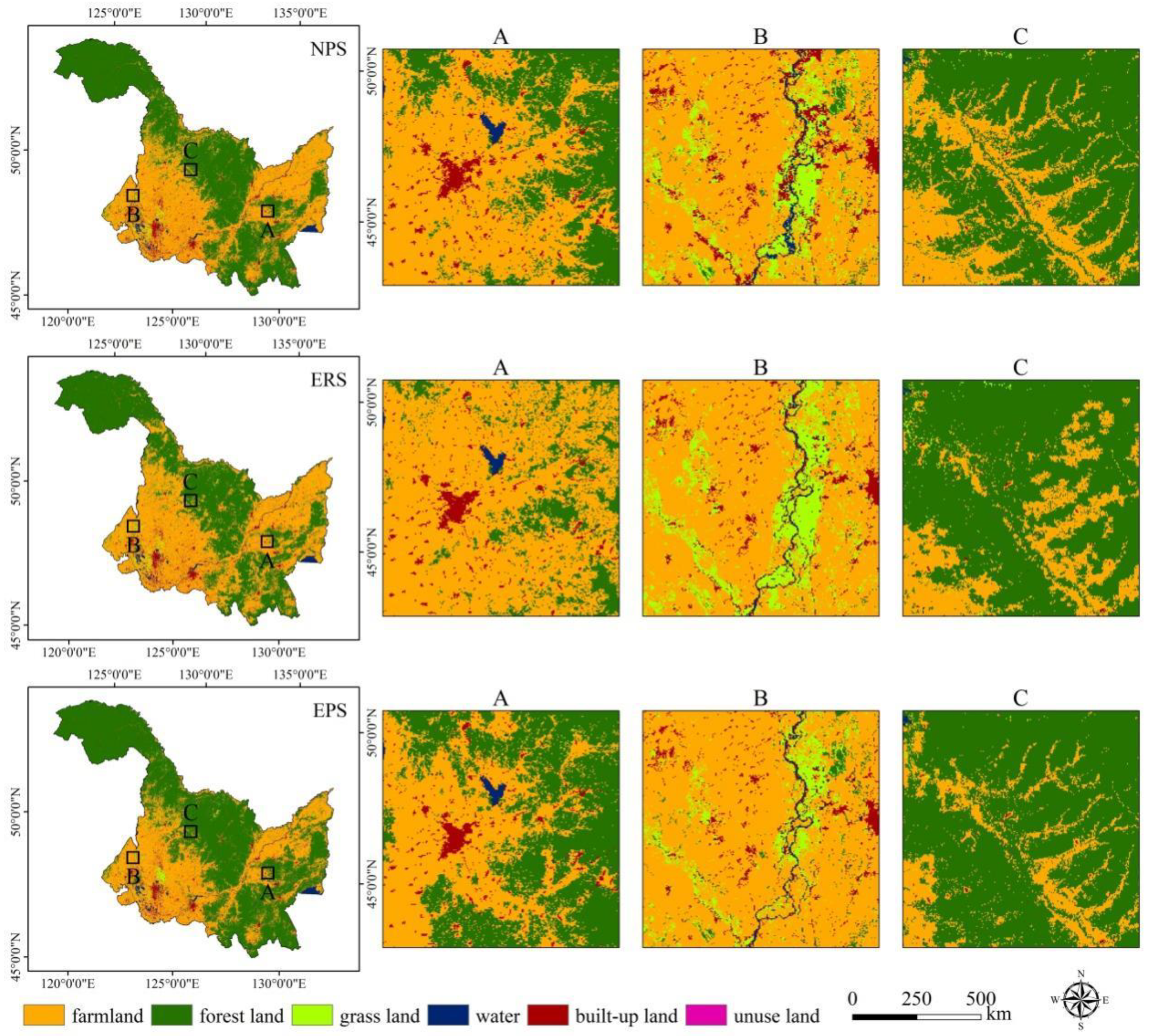
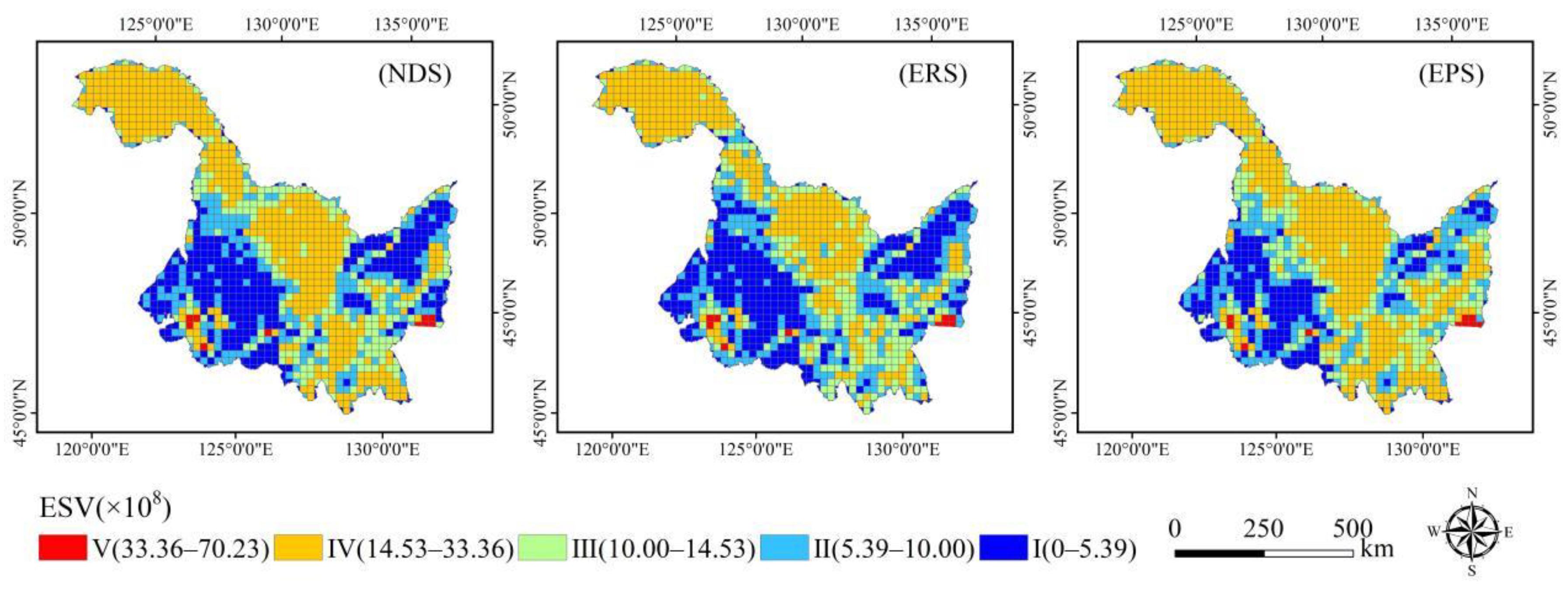

| Data Name | Data Type | Resolution | Time | Data Source |
|---|---|---|---|---|
| Land use data | Raster | 30 m | 2000, 2005, 2010, 2015, 2020 | https://zenodo.org/record/5816591 access on 17 October 2022 |
| DEM, Slope | Raster | 90 m | 2000 | https://www.gscloud.cn/ access on 6 October 2022 |
| Precipitation | Raster | 1000 m | 2020 | https://www.resdc.cn/ access on 12 December 2022 |
| Temperature | Raster | 1000 m | 2020 | |
| Net primary productivity | Raster | 1000 m | 2010 | |
| NDVI | Raster | 1000 m | 2018 | |
| Population | Raster | 1000 m | 2019 | |
| GDP | Raster | 1000 m | 2019 | |
| Nighttime light data | Raster | 1000 m | 2020 | |
| Soil data | Raster | 1000 m | 2010 | http://webarchive.iiasa.ac.at access on 12 December 2022 |
| Administrative center | Vector | — | 2020 | https://lbs.amap.com/ access on 19 October 2022 |
| Rail | Vector | — | 2020 | https://www.openstreetmap.org access on 15 April 2022 |
| Highway | Vector | — | 2020 | |
| Road | Vector | — | 2020 | |
| City road | Vector | — | 2020 | |
| Constraint | Vector | — | 2020 | |
| Socio-economic data | — | — | 2000, 2005, 2010, 2015, 2020 | http://tjj.hlj.gov.cn/tjj/c106782/common_zfxxgk.shtml access on 8 December 2022 |
| Type | Price (Yuan/kg) | Area (×104 ha) | Yield (kg/ha) |
|---|---|---|---|
| Wheat | 2.27 | 4.87 | 3839 |
| Corn | 2.20 | 548.07 | 6654 |
| Soybean | 4.63 | 483.21 | 1905 |
| Rice | 2.83 | 387.20 | 7480 |
| Constraint Type | Constraint (km2) | Description |
|---|---|---|
| Total area constraint | Total area of land type remains unchanged. | |
| Farmland constraint | According to “Heilongjiang Province 2035 Territorial Spatial Planning”, the target of the province’s farmland by 2035 is 166,622 km2. | |
| Forest land constraint | According to the “Heilongjiang Province 2035 Land Spatial Plan” proposed strict control of forest land protection and policies, by 2035, the province’s forest coverage rate should reach 44.26% | |
| Grass land constraint | From 2010 to 2020, the grassland area shows a decreasing trend, taking the 2020 grassland area as the lower limit and the Markov predicted grass land area as the upper limit. | |
| Water constraint | The area of water bodies showed a slow increasing trend during the study period. In order to further promote the optimization of the pattern of blue-green space and improve the deployment of water resources in the region, the area of water bodies in 2020 was taken as the lower limit and the area of water bodies predicted by Markov as the upper limit. | |
| Built-up land constraint | Built-up land shows a continuous trend of expansion, with the area increasing year by year. In order to further improve the efficiency of land space utilization and optimize the spatial development pattern of cities and towns, 1.1 times the construction land in 2020 will be used as the lower limit, and the predicted area of Markov will be used as the upper limit. | |
| Unused land constraint | Setting unused land should not be less than the Markov predicted area. | |
| Farmland and ecological land constraints | To further implement the national food security strategy, and the construction of ecological space protection pattern, set the area of farmland, forest land, grass land, and water not less than 80% of the province’s area. | |
| Reserved land constraint | To reserve space for the sustainable development of construction land and the construction of public space within the city, the area of grass land and unused land is set at no less than 1% of the province’s area. |
| Farmland (km2) | Forest (km2) | Grass (km2) | Water (km2) | Built-Up (km2) | Unused (km2) | |
|---|---|---|---|---|---|---|
| 2000 | 202,155 | 224,613 | 7833 | 6244 | 9516 | 2029 |
| proportion | 44.69% | 49.65% | 1.73% | 1.38% | 2.10% | 0.45% |
| 2005 | 198,198 | 226,149 | 9256 | 6425 | 10,630 | 1732 |
| proportion | 43.81% | 49.99% | 2.05% | 1.42% | 2.35% | 0.38% |
| 2010 | 197,188 | 226,678 | 8613 | 6771 | 11,913 | 1228 |
| proportion | 43.59% | 50.11% | 1.90% | 1.50% | 2.63% | 0.27% |
| 2015 | 203,142 | 221,007 | 6992 | 7291 | 13,178 | 929 |
| proportion | 44.89% | 48.84% | 1.55% | 1.61% | 2.91% | 0.21% |
| 2020 | 202,269 | 221,514 | 5964 | 7424 | 14,592 | 776 |
| proportion | 44.70% | 48.95% | 1.32% | 1.64% | 3.22% | 0.17% |
| Farmland | Forest | Grass | Water | Built-Up | Unuse | Total | Transfer | |
|---|---|---|---|---|---|---|---|---|
| Farmland | 181,583 | 9544 | 3071 | 1517 | 6245 | 194 | 202,155 | 20,572 |
| Forest | 13,411 | 209,904 | 598 | 188 | 394 | 118 | 224,613 | 14,708 |
| Grass | 3520 | 1422 | 2011 | 95 | 731 | 54 | 7833 | 5822 |
| Water | 515 | 262 | 25 | 5107 | 312 | 23 | 6244 | 1137 |
| Built-up | 2200 | 144 | 169 | 306 | 6664 | 33 | 9516 | 2852 |
| Unuse | 1015 | 203 | 88 | 129 | 241 | 354 | 2029 | 1676 |
| Total | 202,243 | 221,479 | 5962 | 7342 | 14,587 | 776 | 452,538 | |
| Transfer | 20,661 | 11,574 | 3951 | 2235 | 7924 | 422 | 46,767 |
| Farmland | Forest | Grass | Water | Built-Up | Unuse | Total | |
|---|---|---|---|---|---|---|---|
| 2000 | 1623.24 | 9676.84 | 314.15 | 1593.43 | 0.00 | 0.82 | 13,208.49 |
| 2005 | 1591.52 | 9742.98 | 370.51 | 1639.17 | 0.00 | 0.71 | 13,344.88 |
| 2010 | 1583.57 | 9765.97 | 344.02 | 1727.04 | 0.00 | 0.50 | 13,421.10 |
| 2015 | 1631.32 | 9518.04 | 280.18 | 1846.12 | 0.00 | 0.38 | 13,276.04 |
| 2020 | 1624.26 | 9540.34 | 238.69 | 1880.60 | 0.00 | 0.32 | 13,284.20 |
| Farmland (km2) | Forest (km2) | Grass (km2) | Water (km2) | Built-Up (km2) | Unused (km2) | |
|---|---|---|---|---|---|---|
| NDS | 174,185 | 222,758 | 4775 | 7839 | 18,507 | 474 |
| ERS | 218,246 | 201,925 | 5964 | 7423 | 18,507 | 474 |
| EPS | 166,622 | 256,790 | 4775 | 7839 | 16,038 | 474 |
| Farmland | Forest | Grass | Water | Built-Up | Unused | Total | |
|---|---|---|---|---|---|---|---|
| 2020 | 1624 | 9540 | 239 | 1881 | 0 | 0.32 | 13,284 |
| NPS | 1591 | 9593 | 191 | 1967 | 0 | 0.19 | 13,343 |
| ERS | 1752 | 8696 | 239 | 1861 | 0 | 0.19 | 12,548 |
| EPS | 1338 | 11,059 | 191 | 1968 | 0 | 0.19 | 14,556 |
Disclaimer/Publisher’s Note: The statements, opinions and data contained in all publications are solely those of the individual author(s) and contributor(s) and not of MDPI and/or the editor(s). MDPI and/or the editor(s) disclaim responsibility for any injury to people or property resulting from any ideas, methods, instructions or products referred to in the content. |
© 2023 by the authors. Licensee MDPI, Basel, Switzerland. This article is an open access article distributed under the terms and conditions of the Creative Commons Attribution (CC BY) license (https://creativecommons.org/licenses/by/4.0/).
Share and Cite
Jiang, Y.; Du, G.; Teng, H.; Wang, J.; Li, H. Multi-Scenario Land Use Change Simulation and Spatial Response of Ecosystem Service Value in Black Soil Region of Northeast China. Land 2023, 12, 962. https://doi.org/10.3390/land12050962
Jiang Y, Du G, Teng H, Wang J, Li H. Multi-Scenario Land Use Change Simulation and Spatial Response of Ecosystem Service Value in Black Soil Region of Northeast China. Land. 2023; 12(5):962. https://doi.org/10.3390/land12050962
Chicago/Turabian StyleJiang, Yun, Guoming Du, Hao Teng, Jun Wang, and Haolin Li. 2023. "Multi-Scenario Land Use Change Simulation and Spatial Response of Ecosystem Service Value in Black Soil Region of Northeast China" Land 12, no. 5: 962. https://doi.org/10.3390/land12050962
APA StyleJiang, Y., Du, G., Teng, H., Wang, J., & Li, H. (2023). Multi-Scenario Land Use Change Simulation and Spatial Response of Ecosystem Service Value in Black Soil Region of Northeast China. Land, 12(5), 962. https://doi.org/10.3390/land12050962







